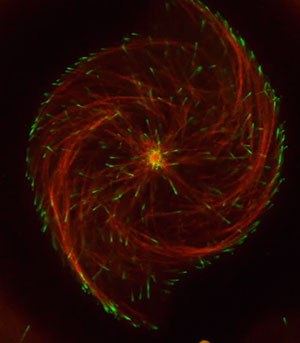UW Molecular Biology Students Video Wins National Honors, Featured by NIH Director
Published February 21, 2020

A University of Wyoming doctoral student’s video showing the spinning motion of microtubules in an artificial cell won national honors and is featured this week on the National Institutes of Health director’s blog.
Abdullah Bashar Sami, from Bangladesh, working in the laboratory of Jay Gatlin, an associate professor in the Department of Molecular Biology, made the video to characterize forces generated by microtubules, filaments of protein that make up a part of a typical cell’s cytoskeleton, the structure that helps cells maintain their shape and internal organization.
The colorful video resembles the rotating clouds in an overhead view of a hurricane -- except the microtubules are spinning clockwise. This star-like microtubule array works to move the nucleus -- and DNA -- to the cell’s center to make sure the cell’s chromosomes are properly positioned for division, Gatlin says.
These same microtubule filaments reorganize during cell division to form the mitotic spindle, resembling a football, which separates the copied chromosomes into each of the two daughter cells that result. The position of the spindle tells the cell where to divide. Sami added fluorescent proteins to show the microtubules and their growing tips.
“We’ve taken these beautiful time-lapse movies of this phenomenon that we didn’t expect to see,” Gatlin says. “The asters start spinning and rotating. It’s really striking.”
Gatlin says he was unsure how long the director’s blog with the video would be posted. It can be found at https://directorsblog.nih.gov and is titled, “The Perfect Cytoskeletal Storm.”
The video won first place in the 2019 Green Fluorescent Protein Image and Video Contest sponsored by the American Society for Cell Biology. The contest honors the 25th anniversary of the discovery of green fluorescent protein, transforming cell biology. The video also won honorable mention in the Nikon Small World in Motion contest.
Sami used an extract of cells from the African clawed frog to set the stage for the video. The scientists created and filled, with extract, a cup-like enclosure of about 60 micrometers in diameter -- a micrometer is one millionth of a meter. The microtubules grow -- resembling the curving clouds in an overhead view of a hurricane -- with the help of a protein, shown in green in the video at their tips. The time-lapse video is 200 times normal speed. The microtubules begin bending and buckling as the process continues.
“What we think is happening is, that as these microtubules grow into the wall, they actually push against it and, because the wall can’t move, they push back against the structure,” Gatlin says. “This observation runs counter to published evidence that suggests asters rely on pulling forces, against either the cytoplasm or the sides of the ‘container.’”
To test the pushing model, the UW scientists then made a container shape they predicted would spin the microtubules in a specific direction -- and did.
“It was a surprise just because no one had ever seen it in a cell,” Gatlin says. “We saw it and thought, ‘Wow, this is really interesting,’ and it suggests that pushing can work.”
In addition to Gatlin, those involved in the research are UW Professor John Oakey in the Department of Chemical Engineering and Associate Professor April Kloxin at the University of Delaware. In addition to Sami, UW Molecular and Cellular Life Sciences students involved in the technology development are Zach Geisterfer, of Fort Collins, Colo.; Taylor Sulerud, of Duluth, Minn.; and Guihe Li, from China. Undergraduates are Daniel Zhu, of Laramie; Julianne Carlson, of Cheyenne; and Regan Meyring, of Jackson.
For more about ongoing research in the Gatlin Laboratory, visit www.gatlinlab.org/.

